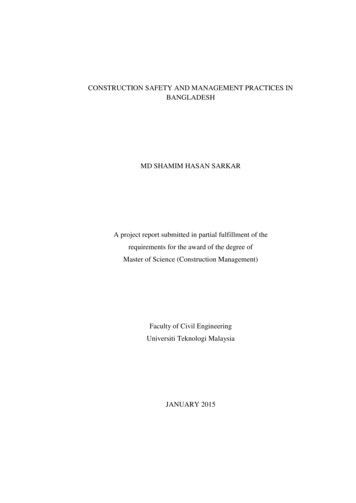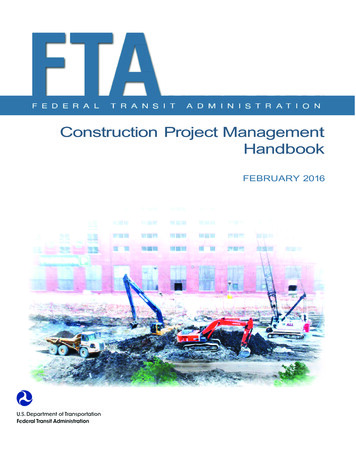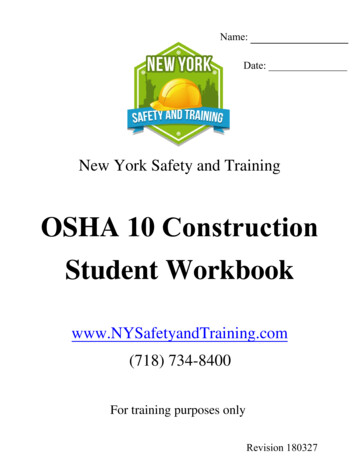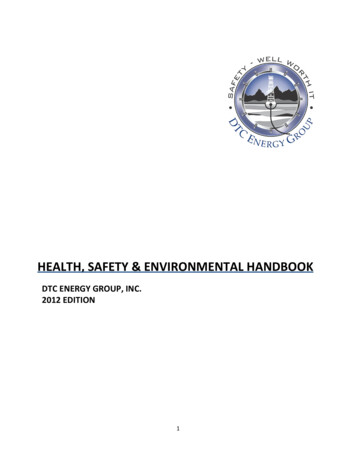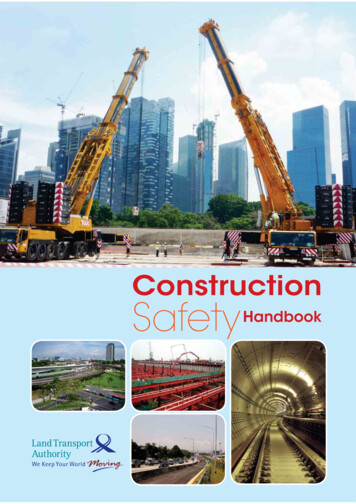
Transcription
ConstructionSafetyHandbook
PERSONAL INFORMATIONAll reasonably practicable steps in accordance to safe and soundpractices must be taken to ensure workplace health, safety andwelfare of all personnel during every phase of construction.Name:Designation:Company:Contact No: Construction Safety Handbook
All rights reserved. This publication is not for commercial purposes.It is intended for the use of the Land Transport Authority’s officersand its Contractors. No part of this publication may be reproducedor transmitted in any form or by any means, in part or whole, withoutthe prior written permission of the Land Transport Authority.Copyright September 2012Land Transport Authority, SingaporePublished by Land Transport AuthorityEnquires can be directed to LTA Safety Division Construction Safety Handbook
Construction Safety Handbook
CONTENTSIntroduction1Construction Safety Indicators3Risk Management5Behavioural Based Safety (BBS)13Confined Space17Electrical Installations33Excavations43Fire Safety55First Aid67Hazardous Substances71Housekeeping77Ladders89Lifting Operations93Lockout Procedure121Machinery Guarding127Scaffolding133Tunnelling149Working At Height157Works Train Operation163Personal Protective Equipment173References183 Construction Safety Handbook
INTRODUCTIONThe Land Transport Authority published its first Construction SafetyHandbook in October 2002. Since then, the Workplace Safetyand Health (WSH) Act and its subsidiaries regulations had beengazetted, replacing the Factories Act. The regulations that followthe Act emphasize the importance of proactive management ofWSH.The 3 principles of the new framework for management of WSHare :a) reducing risk at source;b) instilling greater industry ownership of WSH outcome; andc) preventing accidents through higher penalties for poor WSHmanagement. Construction Safety Handbook
INTRODUCTIONSome of the subsidiary regulations of WSH Act which are applicableto the construction industry are as follows : WSH (General Provisions) (Amendments) Regulations 2011 WSH (Construction) Regulations 2007 WSH (Incident Reporting) Regulations 2006 WSH (First Aid) (Amendment) Regulations 2011 WSH (Medical Examinations) Regulations 2011 WSH (Risk Management) Regulations 2006 WSH (Explosives Powered Tools) Regulations 2009 WSH (Confined Spaces) Regulations 2009 WSH (Operations of Cranes) Regulations 2011 WSH (Scaffold) Regulations 2011This revised Construction Safety Handbook aims to provide projectteams, contractors and consultants a better understanding andemphasis of the updated WSH regulations, LTA’s Safety & Healthrequirements and encourage safe work practices in constructionsites. Construction Safety Handbook
CONSTRUCTION SAFETY INDICATORSAccident Frequency Rate (AFR) :No of MOM Reportable AccidentManhours WorkedX 1,000,000Accident Severity Rate (ASR) :No of Mandays lost due toMOM Reportable AccidentManhours Worked X 1,000,000Construction Safety Handbook
This page is intended to be left blank. Construction Safety Handbook
RiskManagement Construction Safety Handbook
RISK MANAGEMENTWSH (Risk Management) Reg. 4 :The employer, self-employed person and principal shall take allreasonably practicable steps to eliminate any foreseeable riskto any person who may be affected by his undertaking in theworkplace.Where it is not reasonably practicable to eliminate the risk, theemployer, self-employed person or principal shall implement :a) such reasonably practicable measures to minimise the risk; andb) such safe work procedures to control the risk.The measures may include all or any of the following :a) substitution;b) engineering Control;c) administrative Control;d) provision and use of suitable personal protective equipment.Note: Elimination of hazards should take first priority while use of PPEshould be the last line of defence. Construction Safety Handbook
RISK MANAGEMENTHIERARCHY OF RISK CONTROL1. Elimination2. Substitution3. EngineeringControl4. AdministrativeControl5. PPE Construction Safety Handbook
RISK MANAGEMENTStep 3:Risk Control Formulate control measuresaccording to the Hierarchy ofControls Analyse and evaluate residualrisksStep 2:RiskEvaluationStep 1:HazardIdentification Evaluate the risk levels of theworkplace hazards Prioritise the hazards to becontrolled Identify hazards Identify potential accidents orincidents Construction Safety Handbook
RISK MANAGEMENTWSH (Risk Management) Reg. 2 :A ‘hazard’ means anything with the potential to cause bodilyinjury, and includes any physical, chemical, biological, mechanical,electrical or ergonomic hazard.A ‘risk’ means the likelihood that a hazard will cause a specificbodily injury to any person.LTA General Specification :The Contractor shall identify all safety critical activities using therisk matrix (please refer to next 2 pages) and ensure that a methodstatement is prepared for each activity and accepted by theEngineer before commencement of such ely to occur 12 times or more per yearProbableIILikely to occur 4 times per yearOccasionalIIILikely to occur once a yearRemoteIVLikely to occur once in 5 year project periodImprobableVUnlikely, but may exceptionally occurAccident Frequency (LTA General Specification) Construction Safety Handbook
RISK cICriticalIIMarginalIIINegligibleIV Single or Multiple loss of life from injury oroccupational disease, immediately or delayed;and/ or Loss of whole production for greater than 3days and/ or Total loss in excess of 1 million Reportable major injury1, occupationaldisease1 or dangerous occurrence; and/ or Damaged to works or plants causing delaysof up to 3 days; and/ or Total loss in excess of 250,000 but up to 1million Reportable injury2, occupational disease2;and/ or Damage to works or plants causing delays ofup to 1 day; and/ or, Total loss in excess of 25,000 but up to 250,000 Minor injury3, no lost time or person involvedreturns to work during the shift aftertreatment; and/ or Damage to works or plants does not causesignificant delays; and/ or Total loss of up to 25,000Note: (*) If more than one of the descriptions occurs, the severity ratingwould be increased to the next higher level. Applicable to item numbers2 and 3 only.1For man-days lost greater than 7 days2For man-days lost greater than 4 to 7 days3For man-days lost greater than 1 to 3 daysAccident Severity (LTA General Specification) Construction Safety Handbook
RISK MANAGEMENTAccident Severity CategoryRisk CategoryIIIIIIIVCatastrophic Critical Marginal NegligibleIFrequentAAABAccident II ProbableFrequency III OccasionalCategory IVRemoteAABCABCCBCCDVCCDDImprobableRisk Index Matrix (LTA General Specification)Risk Index DescriptionDefinitionAIntolerableRisk shall be reduced by whatevermeans possible.BUndesirableRisk shall only be accepted if furtherrisk reduction is not practicable.CTolerableRisk shall be accepted subject todemonstration that the level of risk isas low as reasonably practicable.DAcceptableRisk is acceptable.Definition of Risk Index (LTA General Specification) Construction Safety Handbook
Construction Safety HandbookSafety and Health Hazard Log (LTA General Specification)F : Frequency (I Frequent, II Probable, III Occasional, IV Remote, V Improbable)S : Severity (I Catastrophic, II Critical, III Margial, IV Negligible)R : Risk Index (A Intolerable, B Undesirable, C Tolerable, D Acceptable)RISK MANAGEMENT
BehaviouralBased Safety(BBS) Construction Safety Handbook
BEHAVIOURAL BASED SAFETY (BBS)LTA General Specification :The Contractor shall implement a BBS programme based on thetraining provided by the Engineer. The BBS programme shall beapproved by the Engineer before implementation.The BBS programme shall include :a) conducting a Safety Culture Survey through questionnaires.The Contractor shall ensure that the Safety Culture Survey isconducted effectively and interpreters shall be appointed ifnecessary;b) training of management staff, site supervisory staff, workersand the appointed observers;c) assigning Observers to conduct observations of safe andunsafe behaviours. The Observers appointed shall base on theratio of 1 Observer to 50 workers. Each Observer shall conductregular observations of at least twice a week, and each durationshall be about 20 minutes each;d) direct Observers to input observations into the Engineer’s BBSDatabase System for monitoring and analysis;e) organise goal setting committees chaired by senior sitemanagement and introduce intervention strategies to correctthe unsafe behaviours for continual improvement. Construction Safety Handbook
BEHAVIOURAL BASED SAFETY (BBS)BBS is a proactive safety approach focusing on motivating individualsto work safely and correct fellow workers’ at-risk behaviours that maylead to an injury. Its ultimate aim is to condition the target group’s way ofthinking and reinforcing positive safety beliefs, values and attitude whichwill then influence their behaviour and building a good safety culture.BBS starts with baseline observation where workers behaviours wereobserved without any intervention based on an established checklist ofcritical behaviours.BBS Implementation Procedure Construction Safety Handbook
BEHAVIOURAL BASED SAFETY (BBS)Based on the result of baseline observation, a goal-setting committeewas formed to set achievable targets for safe behaviour improvement forthe critical behaviours and monitor intervention results according to theintervention cycle below.BBS Intervention CycleStep 1 :Observation results and causes of unsafe behaviours communicated tosupervisorsStep 2 :Train the trainers (supervisors) on methods to promote safe behaviourStep 3 :Discuss and set new goals for next observation cycle Construction Safety Handbook
ConfinedSpace Construction Safety Handbook
CONFINED SPACEWSH (Confined Spaces) Reg. 4 :Where a fixed and stationary confined space is sited in a factory, itshall be the duty of the occupier of the factory to:a) make a record of the description and location of the confinedspace; andb) inform persons who are liable to be exposed to the hazardsof the confined space, of the existence and hazards of theconfined space.Warning signage to inform workers beforeentering into confined space Construction Safety Handbook
CONFINED SPACEWSH (Confined Spaces) Reg. 13 :The authorised manager for a confined space may issue a confinedspace entry permit in respect of entry into or work in the confinedspace if the authorised manager is satisfied that:a) the level of oxygen in the confined space is within the range of19.5% to 23.5% by volume;b) the level of flammable gas or vapour in the confined space isless than 10% of its lower explosive limit;c) the levels of toxic substances in the atmosphere of theconfined space do not exceed the permissible exposure levelsas specified in the First Schedule to the Workplace Safety andHealth (General Provisions) Regulations;d) the confined space is adequately ventilated;e) effective steps have been taken to prevent any ingress ofdangerous gases, vapours or any other dangerous substancesinto the confined space; andf ) all reasonably practicable measures have been taken to ensurethe safety and health of persons who will be entering orworking in the confined space. Construction Safety Handbook
CONFINED SPACEReal-time Gas MonitoringSystemPermit-To-Work displayedon siteProvision of ventilation fan and duct Construction Safety Handbook
CONFINED SPACESS 510: 2005 :Confined space with little natural ventilation and no easy means ofescape for personnel; where there may be dangera) from :(i) excessive concentration of certain gases, such as oxygen,that supports combustion;(ii) the accumulation of flammable or explosive air-gasmixtures;(iii) gases harmful to health; orb) from a combination of such gases; orc) from deficiency of oxygenthe space shall be purged of all flammable or toxic liquids, gasvapours, or dust before any welding or cutting is done and beforeany man enters a confined space. Suitable tests shall be performedby competent persons to ensure that no such hazardoussubstances are present and that the oxygen content of the space isadequate but not excessive. Construction Safety Handbook
CONFINED SPACESS 568: 2011:The confined space safetyassessor shall conduct thetest in the following sequenceunless all are conductedsimultaneously :a) level of oxygen content;b) level of flammable gas orvapour;c) concentration of toxic gasor vapour.Confined space ventilationSource of free air is obstructed Construction Safety Handbook
CONFINED SPACELTA General Specification:Gas monitoring shall be conducted by a competent confinedspace assessor to certify that the confined space is safe for workersto enter and thereafter at every four-hour intervals.Display of gas check Construction Safety Handbook
CONFINED SPACEWSH (Confined Spaces) Reg. 21:It shall be the duty of the responsible person of a person enteringinto or working in a confined space to ensure, before such entry orwork, that the person has first received adequate safety and healthtraining for the purpose of familiarising himself with the hazardsassociated with such entry into or work in the confined space andthe precautions to be observed.Following courses are recommended for Confined Space works : Safety Orientation Course (Manhole) for Workers Safety Instruction Course (Manhole) for Supervisors Confined Space Safety Assessor Course Manhole Safety Assessor Course Occupational First Aid Course Confined Space Entry and Rescue Course Construction Safety Handbook
CONFINED SPACEWSH (Confined Spaces) Reg. 22:An appointed confined space attendant shall remain outside theconfined space in order to :a) monitor persons entering into and working in the confinedspace;b) maintain regular contact with the persons in the confinedspace and when necessary assist them to evacuate should theneed arise; andc) alert the persons appointed to carry out rescue work in theevent of an emergency.Confined space attendant maintaining regularcontact with worker inside confined space Construction Safety Handbook
CONFINED SPACEWSH (Confined Spaces) Reg. 23:It shall be the duty of the responsible person of a person enteringinto or working in a confined space to establish a written rescueplan for the purpose of rescuing persons in the confined space inthe event of an emergency.Emergency flowchartprominently displayedon siteEmergency Escape Route and Assembly Area signs prominentlydisplayed on site Construction Safety Handbook
CONFINED SPACEWSH (Confined Spaces) Reg. 25:No person shall enter or remain, and no person shall require,instruct or direct any person to enter or remain, in the confinedspace for any purpose unless the person entering or remaining inthe confined space:a) is wearing a suitable breathing apparatus;b) has been authorised to enter by a competent person; andc) when reasonably practicable, is wearing a safety harness witha rope securely attached and there is a person keeping watchoutside who is provided with the means to pull him out in anemergency.Use of suitable breathingapparatus in confinedspace Construction Safety Handbook
CONFINED SPACESS 568: 2011:Forced ventilation:The air supply shall befrom a source free fromcontamination.Exhaust ventilation:Confined space be exhausted to a locationoutside the confined space.LTA General Specification:In addition to the requirementsof the WSH (Confined Spaces)Regulations and SS568:2011 (Codeof Practice for Confined Spaces),the contractor shall also classifymanholes, enclosed formwork,culvert drains, excavations morethan 4 meters deep, partiallyenclosed excavations and tunnelsas confined spaces and applyall legislative requirements ofconfined spaces. Construction Safety Handbook
CONFINED SPACELTA General Specification:The Contractor shall ensure that there is an certified man-ridingcage capable of taking a stretcher and two persons, together withan identified crane equipped with rescue equipment, on standbyat all times whilst work is carried out in the confined space.Where this is not reasonably practicable a stretcher which iscapable of being brought manually out of the confined spaceshould be located at a convenient point.Example of man-riding cage which is capable of taking astretcher and two persons together Construction Safety Handbook
CONFINED SPACELTA General Specification:The Contractor shall have controlled access/ egress pointsto confined spaces to prevent unauthorised access. Wherepracticable, the Contractor shall ensure that there are at least tworeadily accessible escape routes from each confined space.Two escape routes from the excavation area Construction Safety Handbook
CONFINED SPACESS 568: 2011:Flowchart of procedures for confined space entry Construction Safety Handbook
This page is intended to be left blank. Construction Safety Handbook
ElectricalInstallations Construction Safety Handbook
ELECTRICAL INSTALLATIONSWSH (Construction) Reg. 35:All electrical wiring in a worksiteshall:a) be supportedinsulators; andonproperb) not be looped over nails orbrackets.Hang cables on properinsulator, not left on wetgroundWSH (Construction) Reg. 35 :No electrical wiring or cable shall be left or laid on the ground orthe floor of a worksite unless it is :a) of the weather-proof type;b) provided with adequate protection to withstand the wear andtear to which it may be subjected; andc) maintained in good and safe working order.Cables left lying on ground Construction Safety Handbook
ELECTRICAL INSTALLATIONSElectrical wiring are not maintained in a safe workingenvironment Construction Safety Handbook
ELECTRICAL INSTALLATIONSWSH (Construction) Reg. 37:It shall be the duty of the occupier of the worksite where anyelectrical installation is used in the worksite to ensure that:a) effective residual current circuit breakers are installed for alltemporary electrical installations to provide earth leakageprotection; andb) overcurrent protective devices with the appropriate ratings areinstalled in the distribution board to provide overcurrent orshort-circuit protection.Distribution board with Residual Current Circuit Breaker(RCCB) and other safety devices Construction Safety Handbook
ELECTRICAL INSTALLATIONSCP 88: Part 1: 2001:All cables are to be installed without obstructing the passageways,walkways, ladders, stairs, etc.Proper cable management Construction Safety Handbook
ELECTRICAL INSTALLATIONSCP 88: Part 1: 2001:All temporary electrical installations shall be inspected by aLicensed Electrical Worker (LEW) at least once a month.Where several voltages are used in the temporary installation, allplugs, sockets outlets and cable couplers shall be identified bydifferent colours:55 VWhite110 VYellow230 VBlue400 VRedSocket outlets identified by differentcolours Construction Safety Handbook
ELECTRICAL INSTALLATIONSCP 88: Part 1: 2001:Warning signage displayed at distribution board shall have theword ‘DANGER’ and the operating voltage of the equipment:a) in block letters of at least 30mm high and 5mm wide;b) in 4 official languages;c) in black against a yellow background; andd) maintained in a clear and legible condition at all times.Recommended dimensions : 280mm X 400mmDB box with warning signage Construction Safety Handbook
ELECTRICAL INSTALLATIONSCP 88: Part 1: 2001:All plugs, socket-outlets and cable couplers likely to be exposedto the weather shall be contained in waterproof enclosures unlessthey are of the weatherproof type.Water-proofed electrical installations Construction Safety Handbook
ELECTRICAL INSTALLATIONSLTA General Specification:A current photograph of the LEW(s) and the contact number(s)shall be displayed on the outside of all boxes containing DBs forease of reference.Display of photo of LEW and contact numberLTA General Specification:The Contractor shall ensure that all hand-held portable electricalappliances and inspection lamps are rated at 110V AC via a stepdown transformer centre tapped to earth (CTE). Construction Safety Handbook
This page is intended to be left blank. Construction Safety Handbook
Excavations Construction Safety Handbook
EXCAVATIONSWSH (Construction) Reg. 77:Where the depth of any excavation exceeds 1.5 metres or wherethe banks are undercut, adequate shoring by underpinning, sheetpiling, bracing or other means of shoring shall be provided toprevent collapse of the excavation, or any structure adjoining orover areas to be excavated.No shoring for excavationexceeding 1.5m Construction Safety Handbook
EXCAVATIONSWSH (Construction) Reg. 77:Where the depth of any excavation in a worksite exceed 4 metres,adequate shoring by underpinning, sheet piling, bracing or othermeans of shoring shall be made or erected in accordance withthe design of a professional engineer to prevent collapse of theexcavation, or any other structures adjoining or over areas to beexcavated.Poling boards extend aboveedges of excavation to act astoeboardsLadder secured to guardrailfor safe access and egressExposed servicesare supportedGuardrails Construction Safety Handbook
EXCAVATIONSWSH (Construction) Reg. 77:The open side of any excavation in a worksite which exceeds 2metres in depth shall be provided with adequate guard-rails toprevent persons from falling into the excavation.Notices shall be put up at appropriate and conspicuous positionsto warn persons about the excavation in a worksite.Notices and guardrailprovided at excavation zoneProper guardrail around a shaft Construction Safety Handbook
EXCAVATIONSWSH (Construction) Reg. 77:Excavated material or other superimposed loads shall be placedaway from the edge of the excavation in a worksite to prevent thematerials or other loads from falling into the excavation, or causethe banks to slip or cause the upheaval of the excavation bed.Equipment and loose materials placed near edge of excavation Construction Safety Handbook
EXCAVATIONSWSH (Construction) Reg. 77:All reasonably practicable measures shall be taken during anyexcavation work in a worksite to prevent any person from:a) being trapped by the collapse of the excavation;b) being struck by an object, such as an excavating machine or byany material dislodged by the machine;c) falling into the excavation; andd) inhaling, or otherwise being exposed to, carbon monoxide orother impurity of the air in the excavation.Working area of excavator was barricaded Construction Safety Handbook
EXCAVATIONSWSH (Construction) Reg. 79:It shall be the duty of the occupier of worksite where any excavationwork is carried out to ensure that:a) safe access to and egress from the excavation in the worksite isprovided where persons are required to work in the excavation;andb) the access and egress is sufficient in numbers and installed insuch locations so as to be readily accessible.Provision of well maintained walkway and access into excavation Construction Safety Handbook
EXCAVATIONSLTA General Specification:Proper walkways shall be provided along struts and walers foraccess and egress. Walkways shall also be provided on plannedemergency escape routes.Proper walkways provided along strutsWalkways were provided to ease evacuation in case ofemergencies Construction Safety Handbook
EXCAVATIONSLTA General Specification:Designated walkways along walers and struts shall be levelled,flushed without tripping hazards and with rigid guardrails and toeboards securely provided.Toe boards and netting are added to preventloose material from falling into excavation Construction Safety Handbook
EXCAVATIONSLTA General Specification:The Contractor shall implement a RFID (Radio-FrequencyIdentification) based personnel tracking system for all deepexcavation works, underground stations and tunnels on site. Thesystem shall track the movement of workers going in and comingout of these areas.The system shall :a) use high frequency (HF) RFID for close proximity sensing;b) allow bi-directional tracking at each access point;c) allow location tracking at one or more access points (includetracking of worker’s last known location to facilitate emergencyrescue works);d) provide instant information update and allow user to view theinformation using standard web browser;e) provide real-time count of workers in one or more locations;f ) trace the entry and exit time of workers at access points;g) track the duration of stay of individual workers at each locationfor each period;h) display the total time spent by workers of each trade; andi) display the additional information such as personnel name, ID,location and entry time stamp. Construction Safety Handbook
EXCAVATIONSRFID gantry waserected to trackaccess to and egressfrom confined spaceRFID Tag taped insideworker’s helmet Construction Safety Handbook
EXCAVATIONSLTA General Specification:Excavators within the excavation pit shall have suitably reinforcedcabin roofs capable of withstanding impact from falling objectsfrom the top of the excavation and its movement coordinatedby one of its operator, who shall be appointed as a leader by theContractor.Excavator with reinforced roof Construction Safety Handbook
Fire Safety Construction Safety Handbook
FIRE SAFETYWSH (General Provisions) Reg. 37:All reasonably practicable steps shall be taken to keep sources ofheat or ignition separate from flammable materials in the factoryor any process carried on at the factory that gives rise to anyflammable gas or vapour.Flammable substance stored at designated storage area awayfrom sources of heat Construction Safety Handbook
FIRE SAFETYSS 510: 2005:All gas cylinders shall be kept away from radiators and othersources of heat. In the case of acetylene and LPG cylinders, theyshould not be stored within 1.5m of an electrical equipment,unless the electrical equipment is of an explosion-proof type. 1.5 mGas cylindersplaced near toradiatorGas cylinder withtrolley Construction Safety Handbook
FIRE SAFETYPressure regulating screwRegulatorFlashback arrestorValves, couplings, regulators, hoses, and flashback arrestors arekept oil-freeSS 510: 2005:Cylinders, cylinder valves, couplings, regulators, hoses, flashbackarrestors and apparatus of oxygen cylinders shall be kept free fromoily or greasy hands or gloves. Construction Safety Handbook
FIRE SAFETYSS 510: 2005:Oxygen cylinders in storage shall be separated from fuel gascylinders or combustible materials (especially oil or grease), for aminimum distance of 6.0 m or by a non-combustible barrier of atleast 1.5m high having a fire-resistance rating of at least ½ hour.6mSeparation of oxygen and acetylene cylinders by a minimumdistance of 6.0mSS 510: 2005:No welding, cutting, or other hot work shall be performed on useddrums, barrels, tanks or other containers until they have beencleaned so thoroughly as to make absolutely certain that there areno flammable materials present or any substances such as greases,tars, acids or other materials which, when subjected to heat mightproduce flammable (or toxic) vapours. Construction Safety Handbook
FIRE SAFETYSS 510: 2005:All equipments used (for welding, cutting and other operationsinvolving the use of heat) should be visually examined at thebeginning of the day, before being used. All hoses must bechecked to ensure they are free from cuts, cracks and other defects.Defective hoses and apparatus must not be used. The gas supplymust be shut off at the regulators before any changing of torches,hoses or other parts is done.Before starting the burning operations, checks must be made toensure that there is no flammable or combustible material nearby.Defective hose should not be used Construction Safety Handbook
FIRE SAFETYWelding area was kept freefrom flammable materials.Fire-extinguisher wasprovided nearby in caseof fireFlammable materials foundaround the welding area Construction Safety Handbook
FIRE SAFETYWSH (General Provisions)Reg. 37:Meansofextinguishingfire shall be provided andmaintained and shall be readilyaccessible, adequate, suitableand tested by a competentperson at regular intervals.Provision offire-extinguishersFire extinguisher was notmaintained Construction Safety Handbook
FIRE SAFETYWSH (General Provisions) Reg. 38:There shall be effective warning devices that :a) are capable of being operated without exposing any person toundue risk;b) are maintained and tested at least once every month;c) give warning in case of fire; andd) are clearly audible throughout the factory.Fire PointElectrical Fire Alarm Construction Safety Handbook
FIRE SAFETYFire point completewith sand bags,fire-extinguishers,shovel, and waterbucketPortable HandCranking Alarm Construction Safety Handbook
FIRE SAFETYWSH (General Provisions)Reg. 38:Effective steps shall be takento ensure that all the personsat work are familiar with themeans of escape and theroutine to be followed in caseof fire .Display of EmergencyEscape RouteLTA General Specification:In-house emergency exercisesand drills shall be conductedon a quarterly basis, table-topexercise with SCDF and allrelevant agencies on a halfyearly basis while drills on ayearly basis.SCDF Drill Construction Safety Handbook
This page is intended to be left blank. Construction Safety Handbook
First Aid Construction Safety Handbook
FIRST AIDWSH (First Aid) (Amendment) Reg. 5:Where more than 25 persons are employed in a workplace, thereshall be person appointed in the workplace as first-aiders whoshall be readily available during working hours such number ofpersons shall complies with the ratio of one first-aider for every100 persons emp
The authorised manager for a confined space may issue a confined space entry permit in respect of entry into or work in the confined space if the authorised manager is satisfied that: a) the level of oxygen in the confined space is within the range of 19.5% to 23.5% by volume; b) the level of flammable gas or vapour in the confined space is
